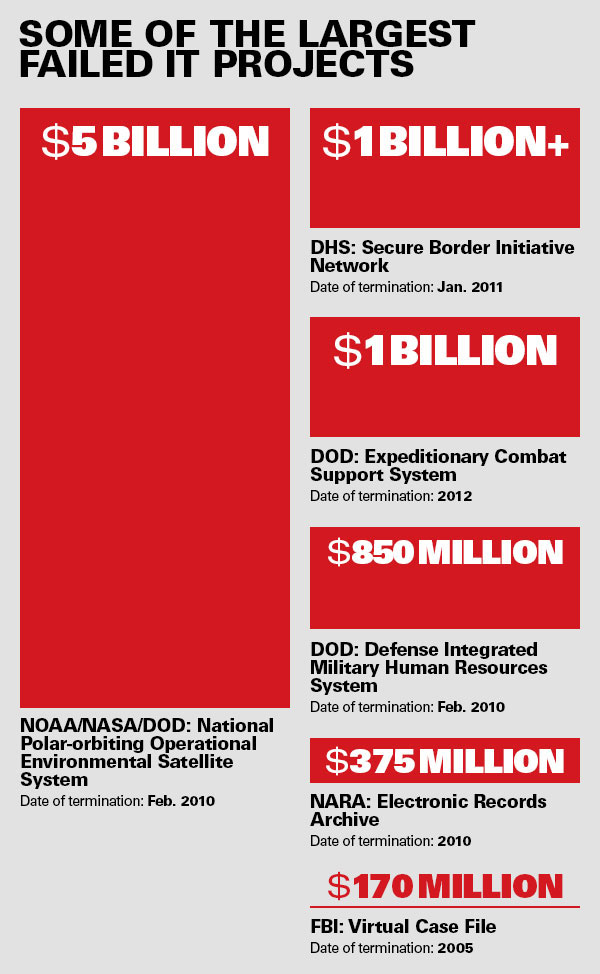Despite progress, billions still at risk in IT investments

The federal government has blown nearly $10 billion on failed IT investments over the past decade, and another $8 billion is currently at risk.

The federal government has blown a documented $9.2 billion on failed IT investments over the past decade. More than 10 percent of its current $82 billion IT budget is at risk. And tens of billions more are tied up in the lifecycle costs of troubled IT projects.
These numbers, generated by the Government Accountability Office through analysis and a series of federal audits, were presented to the House Oversight and Government Reform Subcommittee on Government Operations during July testimony on IT initiatives.
The numbers are ugly by any measure, yet hope exists for more efficiency in federal IT via various Office of Management and Budget-led initiatives. According to GAO, TechStat, PorfolioStat, the Federal Data Center Consolidation Initiative and the Federal IT Dashboard have each realized varying levels of cost savings or cost avoidance.
Most notable is TechStat, which has identified $4 billion in savings since 2010 through face-to-face, evidence-based accountability reviews of large IT acquisitions, according to OMB.
As of April 2013, OMB had conducted 79 TechStat sessions at 23 agencies to realize the savings, and TechStat played a role in the termination of five major IT acquisitions. Dave Powner, GAO's director of IT management issues and one of the witnesses who testified in July, said that in 2010 and 2011, when the majority of TechStats took place, "more systems were stopped and terminated than I can recall happening before."
PortfolioStat, created by OMB in 2012 primarily to reduce duplication across government IT portfolios, has thus far achieved nearly $900 million in cost savings, and according to OMB has identified $2.5 billion in future cost savings. And FDCCI, OMB's attempt to save money through data center consolidation, will achieve about $63 million in savings through fiscal 2013, and another $575 million by fiscal 2014's close.
Yet these initiatives remain far from optimal.
The IT Dashboard, launched to increase oversight and transparency, often offers only a sliver of the transparent truth it is supposed to provide taxpayers on troubled IT investments. GAO found several agencies reportedly evaluate troubled or risky projects as OK. Not all agencies report regularly, either. The Defense Department has not updated its IT Dashboard in approximately two years, much to the ire of legislators and federal CIO Steven VanRoekel, who talked about the agency's infrequent updates in his July 25 testimony.
In addition, several large IT projects received multiple TechStat reviews without corrective action being taken, including DOD's Expeditionary Combat Support System, which reportedly received three TechStats before it was finally terminated. ECSS was an epic IT failure by any definition, yet it was canceled in 2012 only after DOD had already spent $1 billion.
So GAO has called for more TechStat reviews, in part because they shed light on large-scale, high-value IT acquisitions, and urged agencies to pay them more heed.
PortfolioStat, meanwhile, has thus far identified only a small chunk of the $5 billion to $6 billion some officials believe the initiative could potentially save. But ridding duplicative, shoddy IT investments – which often involves severing ties with legacy contractors – will require CIOs with more power than most currently have, Powner testified. The Federal IT Acquisition Reform Act (FITARA) could grant CIOs those powers, but its future is anything but certain.
And FDCCI, which was rolled into PortfolioStat in early 2013, has come under criticism from Congress for its lack of results. It was supposed to save $3 billion to $5 billion by 2015, yet its documented savings to date are paltry in comparison.
Subcommittee Chairman John Mica (R-Fla.) did not mince words after learning the federal government was somehow farther away from its goal of closing 40 percent of agency data centers in July than it was when FDCCI was created in 2010.
Prompted by findings from GAO, OMB disclosed in July that its reworked definition of the term "data center" increased the number of counted data centers from 3,133 to more than 7,000.
"From a consolidation standpoint, it looks like we're stuck in neutral or gone in reverse," Mica said.
NEXT STORY: David Wennergren on the role of the CIO




